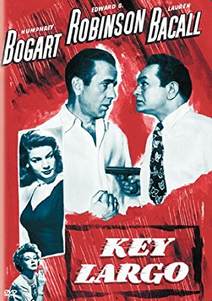Bogie classic psychological drama of mobsters and the good guys___8/10
Reviewed by Brian R. Wright
 Lots of little reasons add up to make this a big movie. It’s sometimes easy to dismiss an old film for its antiquated technology. A movie like Key Largo, today, reminds one of a play being performed for cameras in a big building on the Warner Brothers property in Burbank, CA—which of course it was.
Lots of little reasons add up to make this a big movie. It’s sometimes easy to dismiss an old film for its antiquated technology. A movie like Key Largo, today, reminds one of a play being performed for cameras in a big building on the Warner Brothers property in Burbank, CA—which of course it was.
But that ‘stage’ quality of old classics actually encourages one to focus on the essentials, namely plot and character. The screenplay was written by director John Huston and Richard Brooks, based on a play by Maxwell Anderson.
The setup: Frank McCloud (Humphrey Bogart) is passing thru the Florida Keys during the tourist off-season to pay his respects to the father [James Temple (Lionel Barrymore)] of a good friend of McCloud’s who was a member of his unit in World War 2, and killed in action. Temple’s daughter-in-law, Nora (Lauren Bacall), is the widow of Temple’s son… and helping the elderly, wheelchair- bound Temple to run his oceanfront hotel, The Largo.
Before Frank shows up, an underworld entourage with notorious racketeer, Johnny Rocco (Edward G. Robinson), has been exclusively occupying The Largo for several days—using it to stage a substantial criminal financial heist in cooperation with a rival set of mobsters. Rocco’s yacht is initially anchored within sight past the coral reefs. Johnny’s moll, fading singer-performer Gaye Dawn (Claire Trevor) accompanies the Rocco gang… and provides the platform, by the way, for Ms. Trevor to win the Academy Award for Best Supporting Actress that year.
So you can see a delicious recipe of possible story lines springing up. And I haven’t even mentioned the sympathetic American-Indian side-story of a group of Osceolas whom the Temples befriend—a couple of the men being wanted by police for escaping a 30-day confinement for a bar brawl. [One of the men is played by (uncredited, naturally) Jay Silverheels, later of Tonto fame in the Lone Ranger series.]
When I first watched Key Largo, probably back in my Wayne State University days where I worked as an A/V (audiovisual) tech, it was decidedly not memorable to me. Probably because it lacked the punch of a Hollywood action film, and came off so simple as to be prosaic. But progressively, on subsequent viewings, I began to see the major issues being developed in the interplay among four major icons of star power of that era—Bogie, Bacall, Barrymore, Robinson—and a few key other ‘players’: Claire Trevor, the mobster-subordinate class, the Osceolas, even director Huston, hurricane set creator Donald Desmond, and soundtrack composer Max Steiner.
Hence my interest lies in the writing and its execution in the screenplay. The play/ movie, Key Largo, is first and foremost a psychological drama focused on Frank McCloud, Johnny Rocco (and the criminal mind in general), and Gaye Dawn:
- McCloud—Will he step up from his awful and wearying killing and dying experiences in the war to refind his courage, or give in to cynicism: “One Rocco more or less isn’t worth dying for.”
- Rocco—A fascinating portrayal of any criminal consciousness: existing in a power-and-control world divorced from human reality. The power, no matter how great, is an illusion; anything that reminds them of that—a hurricane, someone who knows how to pilot a boat—fills them with abject terror.
- Dawn—The bottle is getting the best of her, yet she also is deeply aware of her humiliation of being pushed around by mobster bully-coward-scum Rocco. Will she break the chains, now in this urgent confrontation between evil and a man who at least has the potential for one more act of bravery?
I’m increasingly coming to regard mainstream Hollywood over the ages as comparable to “the Oligarchy’s” mainstream, mass-mind-manipulative (3M?) 🙂 media. Yet the fact remains that within the confines of our longstanding, pervasive control hierarchy, genuine creativity breaks out all over… much of it never to see the light of a major motion picture release. But the greats of past and present are still great despite my caveat. [Think of professional baseball before blacks were allowed to play.] And Key Largo is one of the greatest.
Well worth the time to mine and relish such a gem.
This post has been read 1202 times!

